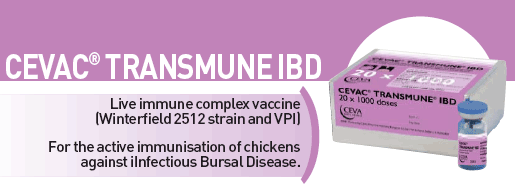The information below is presented by ThePoultrySite.com on behalf of CEVA SANTE AMINALE.
If you wish to contact CEVA SANTE ANIMALE. please visit their contact page
If you wish to contact CEVA SANTE ANIMALE. please visit their contact page

 CEVAC® TRANSMUNE IBD vaccine contains the Winterfield 2512 strain
of Infectious Bursal Disease live virus in complex with IBD immunoglobulins
(VPI : Virus Protecting Immunoglobulins) in freeze-dried form. The embryonated
hen eggs and chickens used in the production of the vaccine are obtained
from specified-pathogen-free (SPF) flocks.
 For the active immunisation of healthy 18-day-old chicken embryos or
healthy day-old chicks against classical or very virulent Infectious Bursal
Disease (Gumboro Disease).
There is no need to revaccinate in the farm against Gumboro Disease. There is no need for determination of MDA level prior to vaccination; the delivery vehicle is timing the vaccine virus release individually, according to the maternally-derived antibody level of the chicks. One full dose is guaranteed to be administered to each chick. There is no risk linked to water administration of usual IBD vaccines.  The vaccine can be administered via in-ovo or subcutaneous injection.
In-ovo injection for embryonated broiler chicken eggs at 18 days of incubation: the dose of rehydrated vaccine is 0.05 ml (i.e. 2,000 doses reconstituted with 100 ml of diluent or 5,000 doses reconstituted with 250 ml of diluent). Subcutaneous injection for day-old chicks: the dose of rehydrated vaccine is 0.1 ml (i.e. 1,000 doses reconstituted with 100 ml of diluent or 2,500 doses reconstituted with 250 ml of diluent). Dissolve completely the freeze-dried contents of the vial in a volume of diluent that complies with the size of the packaging and the route of administration (in–ovo or s.c.). In-ovo injection The embryos should be injected at 18 days of age; a convenient time is when the egg is transferred from the setting to the hatching trays. Prior to injection, check that the position of the egg is correct (long axis vertical, with the air cell pointing up). Only use automatic injection devices that are designed specifically for in ovo injection. After injection, the eggs should be transferred to the hatching trays without delay so as to avoid harming the embryos due to chilling. Subcutaneous injection This injection should be performed appropriately under the skin of the neck of the bird using an automatic or manual injection device.  - Store vaccine between +2°C and +8°C or 35°F and 45°F
- Protect from light  10 x 1,000 dose vials with diluent and wing web applicators.
|
|
|
|
|
GENERAL REMINDER: Product indications, usage instructions & withdrawal periods may vary by Country. Always follow label instructions and consult your veteriarian or poultry health adviser. |
|
This page contains information on veterinary pharmaceutical and biological products that are sold in several different countries and areas where they may be marketed under different trade names and pursuant to different regulatory approvals. Accordingly, ThePoultrySite and CEVA SANTE ANIMALE give no guarantee that the details presented are correct with respect to all locations.
|







